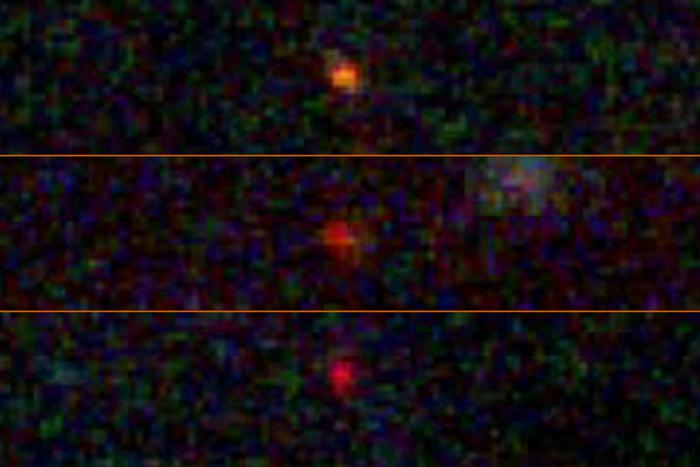A recent study published in the Proceedings of the National Academy of Sciences (PNAS) examines what are known as dark stars, which are estimated to be much larger than our Sun, are hypothesized to have existed in the early universe, and are allegedly powered by the demolition of dark matter particles. This study was conducted using spectroscopic analysis from NASA’s James Webb Space Telescope (JWST), and more specifically, the JWST Advanced Deep Extragalactic Survey (JADES), and holds the potential to help astronomers better understand dark stars and the purpose of dark matter, the latter of which continues to be an enigma for the scientific community, as well as how it could have contributed to the early universe.
“Discovering a new type of star is pretty interesting all by itself but discovering it’s dark matter that’s powering this—that would be huge,” said Dr. Katherine Freese, who is a professor in the Department of Physics at The University of Texas at Austin (UT Austin), and a co-author on the study.
The dark star candidates designated JADES-GS-z13-0, JADES-GS-z12-0, and JADES-GS-z11-0 are estimated to have existed between approximately 320 million to 400 million years after the Big Bang. They were initially identified as potential galaxies, and the sizes of these candidates are estimated to be approximately 1 million times more massive than our Sun and 1 billion times brighter, as well.
There are ongoing hypotheses regarding the first generations of star types that inhabited the universe right after the Big Bang, neither of which have ever been observed: hydrogen burning Population III stars and dark stars. However, like all scientific discoveries, follow-up observations by JWST are required to confirm these findings. If these candidates are confirmed to be dark stars, they could challenge present cosmological models of the universe based on recent JWST observations that early galaxies are larger than they should be.
“It’s more likely that something within the standard model needs tuning, because proposing something entirely new, as we did, is always less probable,” said Dr. Freese. “But if some of these objects that look like early galaxies are actually dark stars, the simulations of galaxy formation agree better with observations.”
The question about dark stars began more than 15 years ago with a conversation between Dr. Freese and a colleague, Dr. Douglas Spolyar, who was a PhD student at the University of California, Santa Cruz at the time, about the potential correlation between dark matter and the first stars of the universe. The two eager scientists contacted Dr. Paolo Gondolo, who was an astrophysicist at the University of Utah, and culminated in a 2008 study published in Physical Review Letters, with several more studies about the potential for dark stars being published since then.
“We predicted back in 2012 that supermassive dark stars could be observed with JWST,” said Dr. Cosmin Ilie, who is an assistant professor of physics and astronomy at Colgate University, and lead author of the paper. “As shown in our recently published PNAS article, we already found three supermassive dark star candidates when analyzing the JWST data for the four high redshift JADES objects spectroscopically confirmed by Curtis-Lake et al, and I am confident we will soon identify many more.”
What new discoveries will scientists make about dark stars in the coming years and decades? Only time will tell, and this is why we science!
As always, keep doing science & keep looking up!


Dark stars are exciting, since the simplest dark matter models will decay due to interaction with gravity. [“How heavy is Dark Matter? Scientists radically narrow the potential mass range for the first time”, Sussex university, 2021.]
The here suggested supersymmetric neutralino WIMPs are now mostly excluded by LHC and even more stringently by electron roundness measurements. [“Measurement of electron’s ‘shape’ dims hopes for discovery of new particles”, Science, 2023.] But the possibly matter/antimatter asymmetry explaining – in that case self-annihilating – sterile neutrinos fits more snuggly with the standard particles and are claimed to hide from common detection. [“Neutrinos may solve the mystery of dark matter”, Nature, 2022.] It is possible that they could fit dark star detections though, so if dark stars becomes a thing maybe we will see some research into that.
“If these candidates are confirmed to be dark stars, they could challenge present cosmological models of the universe based on recent JWST observations that early galaxies are larger than they should be. “It’s more likely that something within the standard model needs tuning, because proposing something entirely new, as we did, is always less probable,” said Dr. Freese.”
Even more likely is that it is a measurement problem of extending current procedures that far back. [“JWST’s “too massive” galaxy problem solved?! | A non-universal IMF”, Dr. Becky Smethurst, 2023.]
But the dark star candidate status of these three objects are not affected by that, I think.